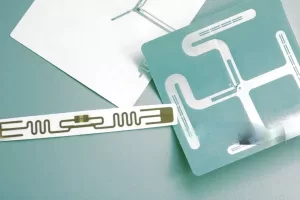RFID technology has been around for a while, helping businesses track and manage products effectively. Traditionally, RFID tags have been made with rigid silicon chips, making them a little bulky and costly. But things are changing. Thanks to flexible and printed electronics, RFID tags are now thinner, more adaptable, and cheaper to produce. This is opening up new possibilities for industries like retail, logistics, and healthcare.
What Makes Flexible and Printed Electronics Special?
Unlike traditional electronics that use rigid materials, flexible and printed electronics use materials like plastic, paper, and even fabric. Instead of the usual manufacturing processes, electronic circuits are printed using special conductive inks, which are applied in layers to create functional circuits. These inks, often made from silver, copper, or carbon-based materials, allow electrical signals to pass through even on soft and flexible surfaces. This means RFID tags can now be bent, stretched, and even embedded into different materials without losing functionality. Since these circuits do not require traditional wiring or bulky components, the overall design remains sleek and lightweight, making them easier to integrate into everyday objects.

Why Does Flexibility Matter?
For starters, these new RFID tags are super thin and lightweight. This makes them perfect for things like product packaging, smart labels, and wearable devices. Since they don’t rely on expensive silicon chips, they are much cheaper to manufacture, making RFID technology more accessible for everyday applications.
There’s also an environmental benefit. Traditional RFID tags are difficult to recycle because of their silicon and metal components. But printed RFID tags can be made with biodegradable or recyclable materials, making them more eco-friendly.
Another big advantage is flexibility. Older RFID tags had trouble sticking to curved or irregular surfaces. But now, thanks to printed electronics, RFID tags can be applied to everything from medicine bottles to textiles for biometric applications.
Where Are These Tags Being Used?
Retailers are already embedding them into product packaging to track inventory, reducing stock shortages and improving supply chain transparency.
Smart clothing brands are using them in textiles to monitor product movement, helping in automated stock management and reducing losses due to misplaced or stolen items.
In hospitals, printed RFID tags are showing up on medicine bottles and patient wristbands, ensuring proper tracking and safety, minimizing medication errors, and improving patient care by enabling real-time data updates.
The food industry is also starting to use them in packaging to monitor freshness and temperature changes, ensuring compliance with safety standards and reducing food waste by providing accurate shelf-life tracking.
What’s Next?
There are still a few challenges. Printed RFID tags need to be more durable to handle exposure to moisture, heat, and wear-and-tear, especially in environments where extreme conditions are common, such as industrial warehouses or outdoor logistics. Researchers are exploring new materials and protective coatings to improve the longevity of these tags without compromising flexibility. Some also have a shorter read range compared to traditional RFID tags, which limits their usability in large-scale tracking applications. However, advancements in antenna design and signal-boosting techniques are gradually improving performance, making these tags more viable for broader applications. As manufacturing processes become more refined, we can expect flexible RFID tags to achieve better efficiency, durability, and range.
The shift to flexible and printed electronics is making RFID technology more practical and affordable, changing the way industries handle tracking and authentication. With continuous research and investment, these innovations are enabling businesses to integrate RFID into everyday objects easily. From smart labels on groceries to intelligent medical monitoring systems, the impact of flexible RFID is growing rapidly. As production costs decrease and durability improves, we can expect even wider adoption in industries that once found RFID implementation too expensive or complex. Eventually, RFID could become as commonplace as barcodes, finding application in everything from supply chains to consumer experiences.

